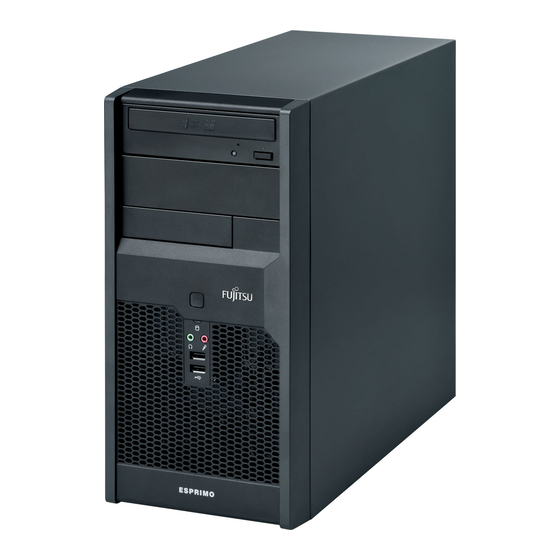
Summarization of Contents
Notational Conventions
Warning and Information Symbols
Explains warning (!), information (i), and action (►) symbols used in the manual.
Text Formatting Conventions
Explains conventions for data entry, screen text, interface elements, and keyboard keys.
Important Notes
Safety Information
Essential safety precautions and warnings for device operation and handling.
Transporting the Device
Guidelines for safely moving the computer system to a new location.
Cleaning the Device
Instructions for properly cleaning the computer and its peripherals.
Energy Saving, Disposal, and Recycling
Information on power saving, waste disposal, and recycling practices.
CE Marking
Details on device compliance with European Union directives and standards.
FCC Class B Compliance Statement
Regulatory statement regarding radio frequency interference compliance.
Getting Started
Unpacking and Initial Setup
Steps for verifying package contents and the initial setup process.
Setting Up the Device and Operating Position
Recommendations for physically setting up the computer and its operating orientation.
Connecting External Devices and Cables
Procedures for connecting and safely disconnecting various cables to the device.
Device Ports Overview
Identification and description of available input/output ports on the system.
Connecting Monitor, Mouse, and Keyboard
Instructions for connecting monitors, USB/PS/2 mice, and USB/PS/2 keyboards.
Connecting Serial and USB Devices
Guides for connecting devices via serial interfaces and USB ports, including drivers.
Mains Connection and Initial Software Installation
Steps for connecting power and the first-time software installation process.
Powering On and Software Installation
Instructions for switching on the monitor/device and installing system software.
Operation
Switching the Device On and Off
Procedures for powering the computer system on and off correctly.
Device Indicators
Explanation of the various status lights (Power, HDD, Floppy, DVD) on the device.
Keyboard Overview and Functions
Details on keyboard layout, keys, and optional power switch functionality.
Important Keyboard Shortcuts
Explanation of key combinations for system functions and Windows shortcuts.
Security and Data Protection Features
Information on protecting the device and data via BIOS and physical security.
BIOS Security and SmartCard Access
Details on BIOS security functions and SmartCard-based access authorization.
Troubleshooting and Tips
Using System Diagnostics for Troubleshooting
Guidance on using the pre-installed SystemDiagnostics program for problem resolution.
Power Indicator and Device Switch Problems
Solutions for the power indicator not turning on or the device not switching off.
Monitor Blank Screen Troubleshooting
Steps to resolve a blank monitor screen issue.
Monitor Configuration and RAM Module Issues
Resolving display configuration problems and incorrect RAM module installation.
Mouse Pointer and Floppy Drive Problems
Solutions for missing mouse cursor and floppy disk read/write errors.
Time/Date Correction and Screen Error Messages
Steps to correct system time/date and interpret screen error messages.
Software and Data Management Tips
Advice on installing software and restoring hard disk contents.
System Expansions
Safety Precautions for System Expansion
Important safety warnings and guidelines before performing system upgrades.
Handling System Boards and ESD Precautions
Guidelines for handling circuit boards and preventing electrostatic discharge damage.
Opening the Computer Casing
Step-by-step instructions for opening the computer chassis safely.
Closing the Computer Casing
Instructions for securely closing the computer chassis after expansion.
Installing System Boards
Procedures for installing new circuit boards into the system slots.
Refitting Slot Covers and PCI Settings
Importance of refitting slot covers and checking PCI BIOS settings.
Removing System Boards
Procedures for removing existing circuit boards from the system.
Refitting Slot Covers After Board Removal
Instructions for refitting slot covers after removing a PCI board.
Removing Accessible Drives (e.g., DVD)
Steps to remove 5.25-inch drives like DVD or CD-ROM drives.
Installing Accessible Drives (e.g., DVD)
Steps to install 5.25-inch drives like DVD or CD-ROM drives.
Installing Accessible 3.5-inch Drives (e.g., Diskette)
Procedures for installing 3.5-inch drives like diskette or multicard readers.
Removing Accessible 3.5-inch Drives (e.g., Diskette)
Procedures for removing 3.5-inch drives like diskette or multicard readers.
Removing the Hard Disk Drive
Procedures for removing the internal hard disk drive from the system.
Installing the Hard Disk Drive
Steps to install a new internal hard disk drive into the system.
Mainboard Upgrades (Memory and Processor)
Information on upgrading main memory (RAM) and replacing the processor.
Replacing the Lithium Battery
Instructions and precautions for replacing the CMOS lithium battery.
Technical Specification
Electrical Data and Safety Standards
Specifications for electrical data, voltage, frequency, current, and safety compliance.
Dimensions, Weight, and Environmental Conditions
Details on physical dimensions, weight, and operating/transportation environmental requirements.













Need help?
Do you have a question about the ESPRIMO P3521 and is the answer not in the manual?
Questions and answers